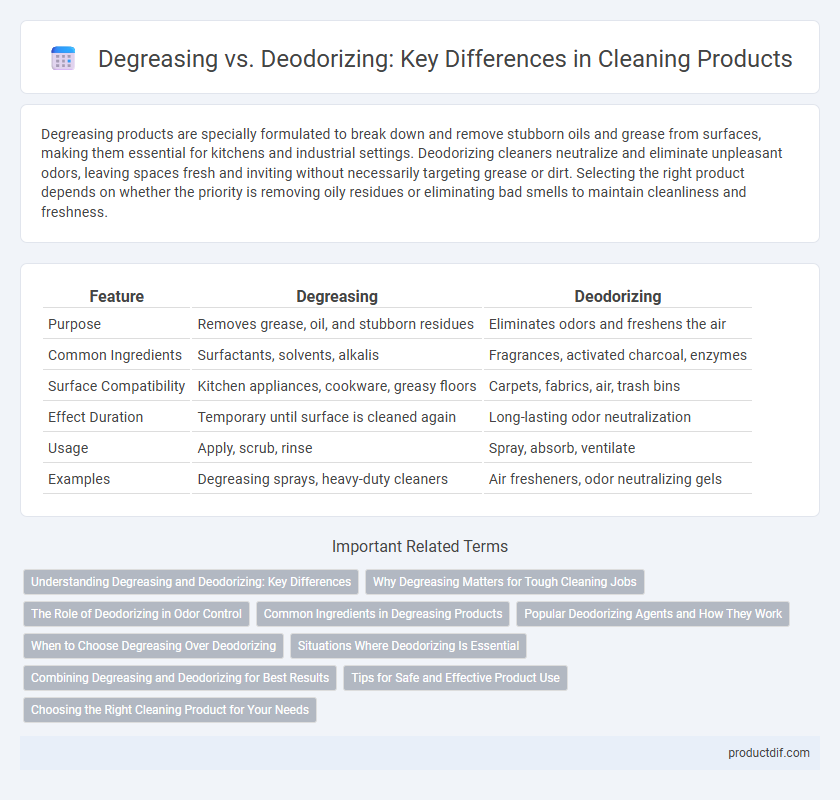Degreasing products are specially formulated to break down and remove stubborn oils and grease from surfaces, making them essential for kitchens and industrial settings. Deodorizing cleaners neutralize and eliminate unpleasant odors, leaving spaces fresh and inviting without necessarily targeting grease or dirt. Selecting the right product depends on whether the priority is removing oily residues or eliminating bad smells to maintain cleanliness and freshness.
Table of Comparison
| Feature | Degreasing | Deodorizing |
|---|---|---|
| Purpose | Removes grease, oil, and stubborn residues | Eliminates odors and freshens the air |
| Common Ingredients | Surfactants, solvents, alkalis | Fragrances, activated charcoal, enzymes |
| Surface Compatibility | Kitchen appliances, cookware, greasy floors | Carpets, fabrics, air, trash bins |
| Effect Duration | Temporary until surface is cleaned again | Long-lasting odor neutralization |
| Usage | Apply, scrub, rinse | Spray, absorb, ventilate |
| Examples | Degreasing sprays, heavy-duty cleaners | Air fresheners, odor neutralizing gels |
Understanding Degreasing and Deodorizing: Key Differences
Degreasing involves breaking down and removing grease, oil, and heavy dirt using alkaline or solvent-based cleaners, making it essential for kitchen and industrial cleaning. Deodorizing targets neutralizing and eliminating unpleasant odors by using chemical agents or natural extracts that neutralize odor-causing molecules without necessarily cleaning surfaces. Understanding these differences helps in selecting the right cleaning product to achieve either surface cleanliness or odor control effectively.
Why Degreasing Matters for Tough Cleaning Jobs
Degreasing is essential for tough cleaning jobs because it breaks down and removes stubborn oils, grease, and grime that regular cleaners cannot eliminate. Effective degreasers penetrate surfaces to dissolve heavy buildup, improving cleanliness and preventing residue that attracts dirt. Without proper degreasing, deodorizing alone cannot address the root causes of odors, making grease removal critical for comprehensive cleaning.
The Role of Deodorizing in Odor Control
Deodorizing plays a crucial role in odor control by neutralizing and eliminating unpleasant smells at their source rather than masking them. Effective deodorizing agents often contain antimicrobial properties that target odor-causing bacteria, offering long-lasting freshness. Unlike degreasing, which primarily removes oily residues, deodorizing ensures a clean, odor-free environment, enhancing overall hygiene.
Common Ingredients in Degreasing Products
Common ingredients in degreasing products include surfactants such as sodium lauryl sulfate and nonionic detergents that break down grease and oils effectively. Solvents like citrus terpenes and alcohols enhance the removal of stubborn residues by dissolving oily substances. Enzymes, particularly lipases, target and degrade lipid molecules, making degreasers efficient for heavy-duty cleaning tasks.
Popular Deodorizing Agents and How They Work
Popular deodorizing agents in cleaning products include activated charcoal, baking soda, and essential oils, each targeting odors at their source. Activated charcoal adsorbs odor-causing molecules through its porous surface, while baking soda neutralizes acidic and basic odor compounds by balancing pH levels. Essential oils mask unpleasant smells with natural fragrances and possess antimicrobial properties that inhibit odor-causing bacteria.
When to Choose Degreasing Over Deodorizing
Choose degreasing over deodorizing when surfaces have stubborn oil, grease, or grime that requires removal rather than simply masking odors. Degreasing products contain powerful surfactants and solvents designed to break down and lift greasy residues from kitchen appliances, industrial equipment, and automotive parts. Use deodorizing sprays primarily for neutralizing unpleasant smells in fabrics, trash areas, or pet zones, but rely on degreasers for deep, effective cleaning of oily messes.
Situations Where Deodorizing Is Essential
Deodorizing is essential in situations involving persistent odors caused by bacteria, mold, or smoke, which cannot be eliminated through degreasing alone. Environments like kitchens, bathrooms, or pet areas often require deodorizing to neutralize unpleasant smells and ensure a fresh atmosphere. Choosing a cleaning product with odor-neutralizing agents is crucial for maintaining hygiene and comfort in such spaces.
Combining Degreasing and Deodorizing for Best Results
Combining degreasing and deodorizing in cleaning products ensures the removal of stubborn grease while eliminating unpleasant odors, delivering a comprehensive cleaning solution. Effective degreasers break down oil and grime at the molecular level, allowing deodorizing agents like essential oils or activated charcoal to neutralize offensive smells. This dual-action approach enhances cleanliness and freshness, making it ideal for kitchen and industrial environments where both grease buildup and odors are common challenges.
Tips for Safe and Effective Product Use
Use degreasing products containing solvents like citrus or ammonia-based formulas for effective removal of grease and oils, and always follow manufacturer guidelines to avoid surface damage or skin irritation. When deodorizing, select products with natural enzymes or essential oils to neutralize odors safely, and ensure adequate ventilation to prevent inhalation of strong fumes. Wear protective gloves during application, test products on small areas first, and keep cleaning agents out of reach of children and pets to ensure safe use.
Choosing the Right Cleaning Product for Your Needs
Selecting the appropriate cleaning product depends on whether you need degreasing or deodorizing capabilities, as degreasers target oil, grease, and stubborn grime by breaking down residues, while deodorizers neutralize unpleasant odors and refresh the environment. For kitchens and automotive parts, concentrated degreasers with surfactants and solvents provide effective grease removal. In contrast, deodorizing products often contain antibacterial agents and fragrances designed to eliminate odor-causing bacteria and leave a fresh scent.
Degreasing vs Deodorizing Infographic

 productdif.com
productdif.com